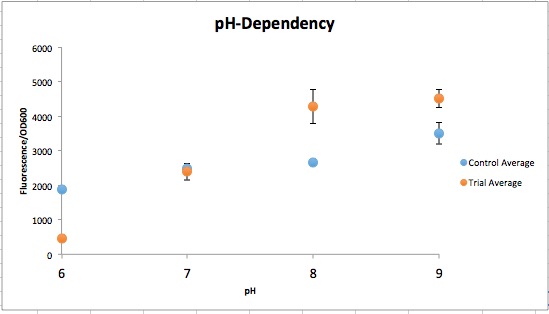A basic part is a functional unit of DNA that cannot be subdivided into smaller component parts. BBa_R0051 is an example of a basic part, a promoter regulated by lambda cl.
Most genetically-encoded functions have not yet been converted to BioBrick parts. Thus, there are many opportunities to find new, cool, and important genetically encoded functions, and refine and convert the DNA encoding these functions into BioBrick standard biological parts.
Note
This page should list all the basic parts your team has made during your project. You must add all characterization information for your parts on the Registry. You should not put characterization information on this page.
CpxA-CpxR is a two-component mechanism that is activated at pH 7.4 and repressed at pH 6.0. CpxA is an intermembrane protein that autophosphorylates at a certain external pH, CpxR (a kinase) then gets phosphorylated by CpxA and acts as a transcription factor. This system originally is a transcription factor for the virF gene, but we replaced virF with the Reporter. This reporter is a YGCP (Bba_K1033916). The original sequence was found in Shigella sonnei, but E. coli has a homolog of these proteins so all that is required on the construct is the appropriate prefix/suffix and CpxR binding site.
The pH-Dependent Graph is the relative fluorescence in Top10 E. coli grown overnight in M9 media. The experimental group contains the CpxR Binding site - Reporter construct in under 4 pH conditions (pH 6-9). The Control Average contains 3 sets and the Trial Average contains 3 sets. The Control is a YGCP without a pH-Dependent Promoter and the Trial is YGCP with a pH-Dependent promoter.
CadC (not submitted)
The CadC operon is a native pathway in E. coli, involved in the cadaverine synthesis pathway. The protein CadC protein on the operon is produced and activates segments downstream of the operon on the CadBA receptors. The CadC protein is pH sensitive to an external pH 5.5 and below, as well as lysine dependent. A point mutation on codon 265, in which argenine is converted to cystine, causes the CadC protein to become lysine independent (Dell, Neely, Olson, 1994). The CadC operon was also used with the BioBrick BBa_E1010, a red chromoprotein to serve as the reporter for the system. <p> Unfortunately, we have been unable to grow the modified CadC operon in E. coli suggesting some form of cell toxicity. Alternative candidates are being explored for other pH sensors that sense in the acidic range. GOX Putative Promoters
GOX sequence information


